Conjoining Europe and Asia, the former Soviet Republic of Georgia is a historical and cultural jewel—and a skier’s dream.
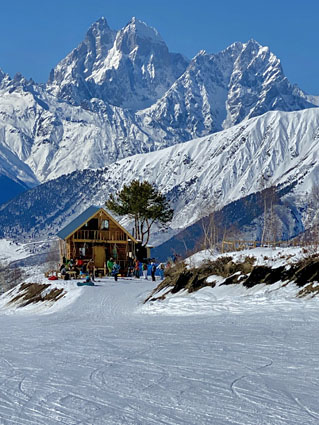
BY IAIN MACMILLAN
PHOTOS BY RAY O’REILLY
My dad got hot boxed in the gondola today,” daughter No. 3 Sophie announced dryly to our new dinner guests Olivier from Switzerland and James from the U.K. We were in the swank new Gudauri Lodge in Georgia’s largest, most international ski resort of the same name. Moments earlier I had busted all three of my daughters for scoping out the two good-looking boys who had just walked into the packed dining room. So I thought I would be the embarrassing dad and invite them to join us. But as I tried to interview the pair of oil-trader expats who’d flown in from Dubai for a few days of winter, I instead quickly found myself outnumbered and on the defensive.
“I don’t smoke weed,” I explained dismissively to our smiling guests. “No, seriously, I don’t smoke anything.” Failing at diverting the conversation, I tried: “Do you know who Ross Rebagliati is?”
With lots of comedic interruptions, I rehashed the day’s laps, including my now infamous, if hazy, last run up.
At the gondola’s mid-station scramble, my wife, Ray, managed to miss the closing doors when she was distracted by Mount Kasbegi, the nearby volcano that peaks out at a dizzying 5,033m and helps define the border with Russia. Consequently, she didn’t quite make it into the happy cabin that I then found myself in. Meanwhile, my three new friends, wearing requisite Georgian beards and smiles and, for my benefit, chatting in English, generously offered to share their Marley-sized spliff while we discussed among other things our pot-smoking PM and their relatively recent court rulings that effectively legalize personal use.
Cannabis tourism aside, Georgia’s meteoric (pre-pandemic) rise in international visitor numbers has too many alluring reasons to list but at the top are its almost overwhelming history, nature, gastronomy, winemaking, religion, architecture, welcoming people, medieval fortresses, cave monasteries…and for skiers: a fabled mountain range, the lower slopes of which now hold some of the world’s newest infrastructure of ski lifts—as well as a lot of snow. Georgia may lie south of the Greater Caucasus (which by physical definitions puts it in Asia), but it’s far more aligned with Europe.
It seems as if throughout history, Georgia (საქართველო in their curiously unique language, or “Sakartvelo” in romanized script) makes it into the news for all the wrong reasons. Just since it broke away from the crumbling Soviet bloc in the early 1990s, I’ve read about wars, corruption and home-boy Joseph Stalin, even a chairlift running backwards at high speed. But when you go beyond the headlines, the country is nothing short of magnetically fascinating.
We had eight days on the ground; we needed 80.
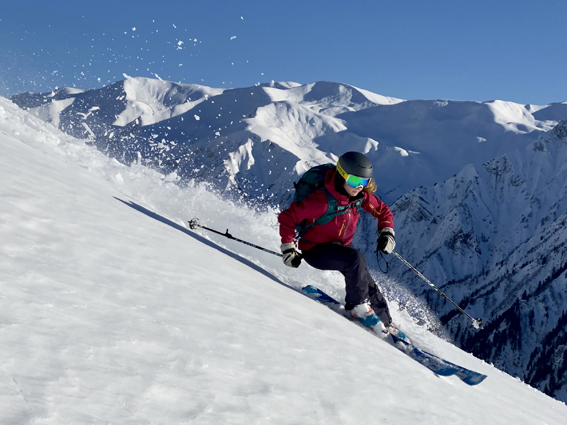
The on-piste, warm-up laps on our one day at Gudauri made us feel as though we were in the high Alps, all above-treeline terrain with wide-open groomed boulevards defining the runs. A freeride and AT paradise, both for terrain and snowfall, Gudauri is Georgia’s Whistler Blackcomb. We followed mountain guide Lasha on an afternoon skin for 30 minutes or so and passed a string of Swedes post-holing it up a powdery and promising north face. On the cold and windy summit ridge, we marvelled at the stellar panoramic views only briefly before clicking in our heels and, one at a time, popping off a small cornice into dry untracked knee-deep for which Georgia has quickly become renowned. We ended the run almost 1,500 vertical metres lower beside the Gudauri Lodge’s enormous outdoor hot tub, whose jets I think were made by Rolls-Royce.
About 40 km of switchbacks south of Jvari Pass on the Russian border, and a two-hour drive along the ancient trans-Georgian Military Highway from Tbilisi’s airport, Gudauri’s 15 new Doppelmayr lifts range in elevation from 1,990 to 3,279m with unlimited touring and bootpacking possibilities seemingly in all directions. A taxi can be arranged to meet skiers on mountain roads, and sled drivers are available some days to give the sick, infirm and lazy a boost into the backcountry.
Heli-skiing rates and airport transfers are considerably lower than Europe or North America. At lower elevations scattered hodgepodge construction cranes were building high-end hotels, with no obvious central village, to meet the demand of mostly foreign skiers escaping climate change. For those on a gap year, sabbatical or retirees, a €200 season pass (half that for Georgians) covers all lifts in the country! Across Georgia, food, drink, accommodation and more can be half or a third the cost of anything similar in North America or the Alps.
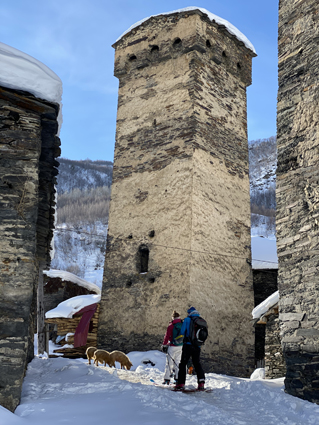
region date back to the 8th century.
Also iconic, the local livestock.
By mid-morning the following day five MacMillans, plus Lasha, were gazing back at sprawling Gudauri from slopes opposite as we made our way up a gentle 770-vertical-metre skin track, first through the trees and then into the alpine. Lasha hadn’t told us about our destination, which turned out to be very popular with AT skiers in the winter and hikers in the summer, the 9th-century Lomisi Monastery. Tall, slim young monks in full black vestments (and some in Full Tilt ski boots) went about their business but also had time to share tea, answer questions and, for those wanting a wish to come true, help you don a 40-kg chain around your neck and then send you walking three times around the ancient stone church’s central column while dour orthodox icons stared down at you in the dark. Legend has it that a bull named Loma meandered home wearing an icon of St. George fixed to its horns while leading highlanders home from captivity in Persia. The church was built where the bull died; then a thousand years or so of history passed.
As a few more skiers arrived, we chatted with a group of Germans, Dutch and Slovenians as well as two mysterious Canadians who appeared on their own. Naomi, if that was her real name, told us they were diplomats working in Turkey. “Naomi” was possibly the least forthcoming Canadian I’ve ever met travelling. Her only slightly less aloof and unnamed partner said he was with the Ontario desk of the Canadian Trade Commissioner Service, although he didn’t know a neighbour of ours who’s been with the CTCS for many years. I debated whether to really get things rolling by asking how long they had been working for CSIS but decided our views in all directions were more interesting.
Lasha just laughed at my suggestion to ski the wide-open untracked back face that lay below the monastery. “Not unless you want to stay in a Russian gulag for at least three months and pay a huge fine to get out,” he said with both a smirk and a scowl. While I was wondering if my kids could find Georgia on a map, I hadn’t realized the ridge we stood on was the “border” with South Ossetia. I used air quotes around “border” because only Russia and a few despot nations formally recognize this 4,000-sq-km political peninsula in the centre of Georgia. Similarly, Abkhazia, in the farthest northwest region of Georgia on the Black Sea, not far from the 2014 Olympics host city of Sochi, falls beyond the same unrecognized dotted-line demarcation on today’s maps.
Separatists in the culturally and linguistically different regions of South Ossetia and Abkhazia first fought a crumbling U.S.S.R. in the late ’80s during the Georgian Civil War and were later successful, with the help of the motherland, in the Russo-Georgian War of 2008. Georgia ended up losing more than 100,000 lives, about 20 per cent of its geography and took in more than 300,000 refugees.
One refugee, Lasha, was four years old when he escaped from Abkhazia with his family. He can’t return today. And the only way for me to reach Abkhazia, or South Ossetia where the tips of my skis were now (without finding myself in the crosshairs of an AK something-or-other), is going through Russia first. As recently as 2017, Russia has scooped up more of Georgia by moving border signs overnight near the main highway at Gori.
It wasn’t Lasha with whom I had been corresponding for months organizing our family’s February adventure; it was Ilia Berulava. As the country’s first IFMGA mountain guide, Ilia is also co-founder of the Georgia Guide Office, which represents 20 mountain and ski guides from its HQ in Svaneti, our next stop in this fascinating country.
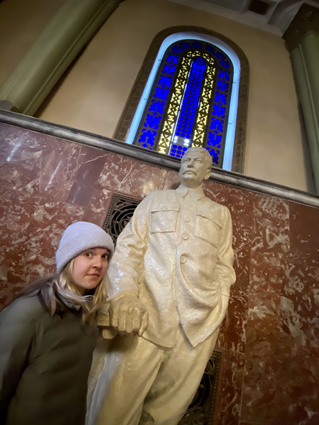
in Gori forgot to mention all the bits
about the famines, massacres, forced labour, detentions…
Our arduous and gritty 11-hour drive around South Ossetia and its mined border took us into Georgia’s subtropical vineyards and farmland with leather-faced men in cool hats on horseback, through towns of weathered wooden cottages and small cities with decaying but still fascinating Soviet apartment blocks, and finally a spectacular, twisty-turny and bumpy drive up tight steep valleys with few guard rails above massive hydro-electric reservoirs. When we return, we might consider flying one way into Kutaisi, which has a much closer international airport to Svaneti. However, the capital of Tbilisi is well worth visiting, and on the way from Mestia an eerie overnight stop at the HIGHLY recommended and mostly abandoned Soviet spa town of Tskaltubo as well as a bizarre stroll through the Stalin museum in the dictator’s birthplace of Gori are must-do’s.
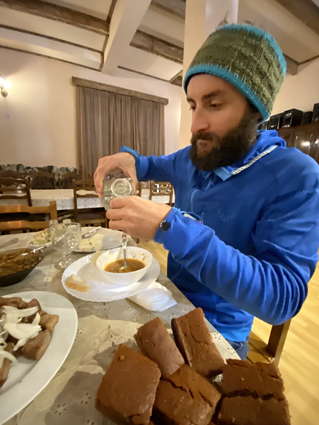
(and the only one we know who’s survived a lightening strike)
Ilia Berulava doles out shots of chacha
after another spectacular Georgian culinary feast.
By the time we fell out of Nico’s little (and for no apparent reason, right-hand drive) Japanese minivan, we were so happy to meet Ilia I expected him to be overwhelmed, but the affable, funny new friend passed the MacMillan test with flying colours. He made us feel as if we’d known him for years, and we were soon sitting down for a delicious dinner at the newly renovated Hotel Posta of traditional khinkali dumplings, ostri (spicy beef stew) and shkmeruli (garlic chicken) while peppering him with questions. Although we couldn’t get Ilia to sing or dance, we learnt later in the week just how cool he was when he casually mentioned being struck by lightning on a mountainside several years ago.
At 4,858m Tetnuldi and its colossal glaciers tower above the seven villages that make up Mestia at around 1,500m. The four-year-old ski resort of the same name was new in 2016 and has five lifts that currently start at 2,265m and top out at 3,160. Like Gudauri, the freeride and touring terrain roams as far up, down and around as the eye can see. The enchanted region that Mestia sits in, Svaneti, gets snow—big snow—so skiing past the lowest lift to one of the seven villages in the valley that make up Mestia will give you a nearly 1,700-vertical-metre run; you and your guide can decide how much to add with your skins, and at such dizzying elevations, the sky’s literally the limit.
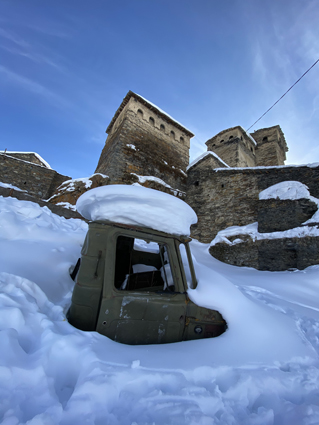
it’s all fascinating.
Known for its massive alpine splendour and hundreds of tower houses, many that date back to the 8th century, Svaneti (the v is pronounced like our w) has its own unique, unwritten language, culture and fierce history. Svans sing complicated a cappella or polyphonic songs. And they’re highland warriors from villages too difficult to surround with protective walls so it was up to each family to build its own six-storey fortress from which to throw stuff Monty Python-style at marauders.
With one scene more magical than the next, we collectively took thousands of photos over the next few days of skiing and skinning slackcountry off the lifts of nearby Tetnuldi, and full days of touring on the flanks of other enormous peaks. Ilia’s itinerary included a night in the remote village of Ushguli (2,100m), about 10 km from Russia, and a day of ski-touring all more spectacular than the last. Sleep came on quickly after vast amounts of exercise combined with overeating from a feast spread out at the dinner table and finished with shots of chacha. What some call “Georgian vodka” of course is made with grapes. No surprise given we were in the country that gave the world wine.
I never find the mesmerizing, almost hypnotic sequence that is ski-touring monotonous. The one-foot-after-another routine allows me to collect my often-scrambled thoughts; I’m away from electronics, work, pestering people… Sometimes tunes run through my head, other times the silence accompanied by the rhythmic swish-and-slide sounds are lulling.
Touring with the MacMillan girls, not so much.
Maybe it just comes down to having three of a kind, but Ray and I produced a noisy lot. “It’s cold!” “I’m SO hot!” “Those pants make you look fat.” “Wait, are you wearing my shirt!?” “What song are you singing?” “Remember that episode in The Office when…?” “Tell us about your girlfriend, Ilia.” Through all the high-elevation huffing and puffing there’s singing, non-stop chatter, stupid questions, laughter… Passing someone on or near the skin track almost always involves full-contact checking.
“Whoa! What’s that double-summit, Ilia?”
“Ushba, 4,710 metres.”
“And over there?”
“Shkara, 5,193.”
“Oy! That one, that one!”
“That’s Russia! That’s Elbrus, 5,642.”
I look at my iPhone. We’re too close to the border for the GPS to place me on a map. I’m also getting a warning about roaming rates in Russia. So cool. Some guides we’ve skied with in the past don’t know what hit them when the five of us show up. Thankfully Ilia was not only patient and flexible, he had a quick sense of humour. We were soon fighting in our little van over who got to sit next to the Georgian hipster who took a lightning bolt to the shoulder and summited every peak we could see.
Planning your Georgian Dream Mountain guide Ilia Berulava and http://www.georgiaguideoffice.comGeorgian National Tourism Administration http://www.georgia.travel



